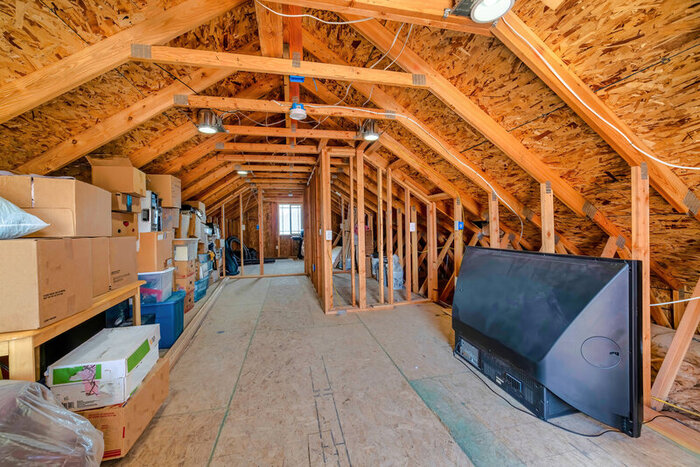
It’s not uncommon for Bay Area attics to be chock-full of stuff, ranging from generations of furniture and trunks to the odd assortment of boxes and seasonal decorations.
While this is understandable, you should only use your attic for storage under certain conditions.
Here are five things that must happen before using your attic as a storage space. If your attic is already being used as a storage unit, we recommend verifying that these “must-haves” or “must-dos” are in place with input from a licensed professional.
If you plan to store more than a few, lightweight, cursory items in the attic, we recommend working with a licensed contractor and finishing the attic as a designated space. In addition to accomplishing everything we’ve listed below, it will increase your home value and give you more options for using the attic space in the future.
Read our post, Before You Turn Your Attic Into a Room. While you don’t need to deck it out in style, the structural and code-specific finishes are worth the time and investment to keep your attic, your stored items, and your household occupants safe and sound.
First and foremost, your attic may not have been designed for storage. Structural safety is essential. If the floor joists in the attic aren’t fitted with secure flooring material - even something as simple as secured plywood rated for the correct weight, you can have a problem.
There is a chance that whatever box or item is the “straw that breaks the attic floor’s back” will cause the attic contents to come crashing down to the areas below it. Similarly, any people who go up and walk or crawl around in the attic to access stored belongings also run the risk of crashing through the attic ceiling.
Any latent moisture damage or unaddressed leaks may have contributed to mold, mildew, and structural rot that require cleanup, sanitation, and repairs before storing anything up there.
Many attics are accessible via square holes in the ceiling that require users to delicately balance on a stepping stool, counter, or ladder to hoist themselves up. Moving down and up into the attic while carrying boxes or furnishings is a major safety hazard.
If you plan to use your attic as a bona fide storage area, schedule a consultation with a licensed contractor and determine the best way to create more safe and accessible attic access. This may mean creating a whole new entrance, but it will be worth it the first time you pull down your attic access door and climb steps that have safety railings for you to hold on to.
Your attic entrance can also be retrofitted with grab bars and other helpful features to make it easier for you to bring things in and out of the space.
Unless your house is 10 years old or less, odds are you have fiberglass insulation batts in place. You may even have these in a newer home if the contractor was trying to save money. Unfortunately, while these are safe insulation materials, fiberglass batts shouldn’t be moved around on a regular basis.
In addition to compromising their R-value and minimizing their energy efficiency, stirred-up fiberglass can irritate skin and get into your respiratory tract. We recommend that homeowners who plan to turn their attic into a storage space consider replacing fiberglass batt insulation with spray foam or rigid foam/plank options to optimize insulation function as well as your health.
Pests love to make attics their home. There, rodents and other pests have a protected, warm, and predator free space to rest or grow their families. This poses multiple problems. First and most importantly, pests are disease carriers and their waste products are toxic. These fumes travel through structural materials and also through HVAC ducts and into your homes conditioned air system.
Secondly, pests in the attic mean pests in your stored furnishings and boxes, which can lead to the costly or invaluable destruction of your heirlooms and possessions. You should clear the attic of any pest evidence, and that includes a full sanitation treatment as the smell of rodent feces will draw other pests into the attic even when you’ve eliminated their predecessors. Attic professionals who offer rodent solutions also seal off any available pest access to keep your attic pest-free in the future.
Read, Pests in the Attic: How They Get There & What to Do About It.
Finally, adequate ventilation and moisture control are a must. These are actually mainstays of a healthy attic and whole-home energy system anyway. By ensuring adequate ventilation and moisture control in the attic, you’ll simultaneously improve energy efficiency and indoor air quality.
If you’re converting your attic into a storage space, attic ventilation and moisture control are doubly important. Without those two features, Bay Area attics have a tendency to have high humidity levels and the damp can affect your stored items, putting them at risk for rot, mold, and/or a mildew infestation.
Bonus Tip: Before you go remodeling the attic, evaluate your roofing system. Roofs and attics are siblings in the whole-home structural system. Updating the attic when the roof is due for replacement is a waste of time, energy, and money. The roof system should be repaired or replaced first, followed by the attic updates.
Are you interested in expanding your home’s living or storage space by updating the attic? Contact the team at Attic Solutions to schedule a free consultation and to glean expert insider tips.